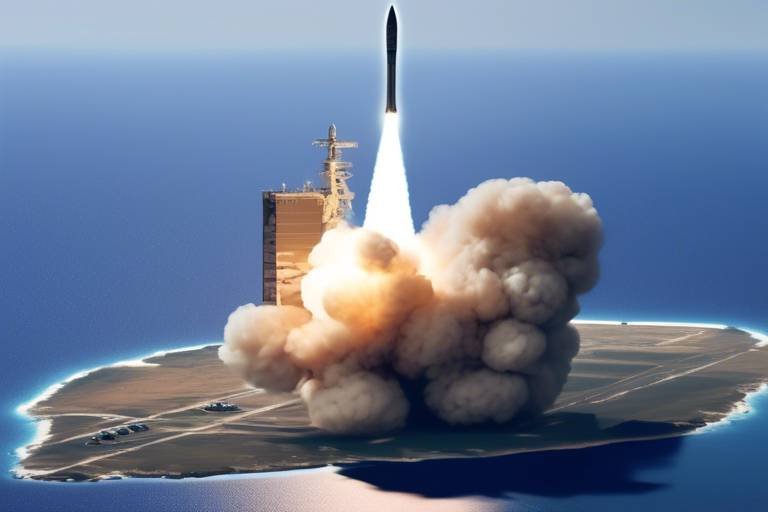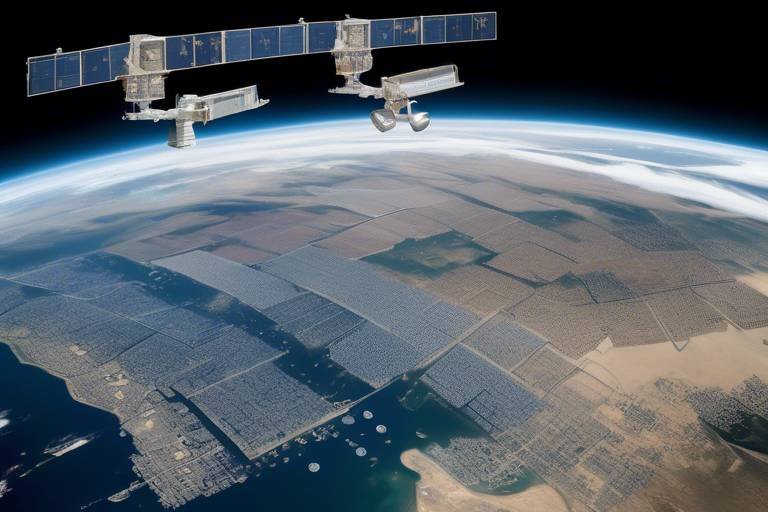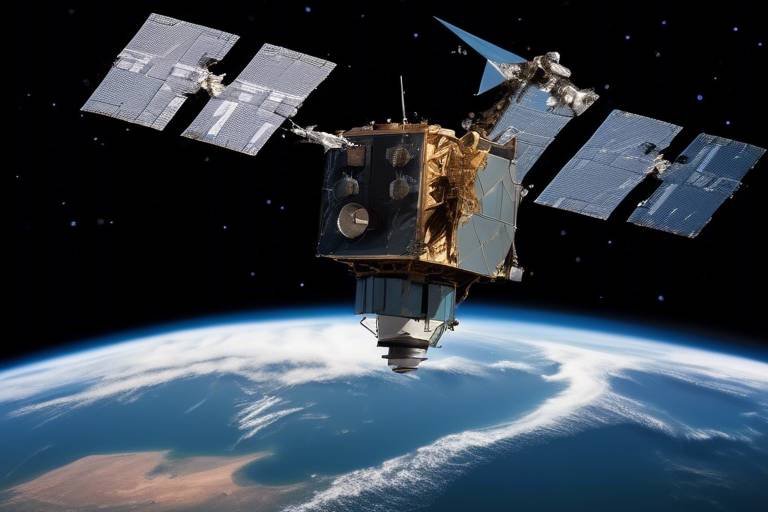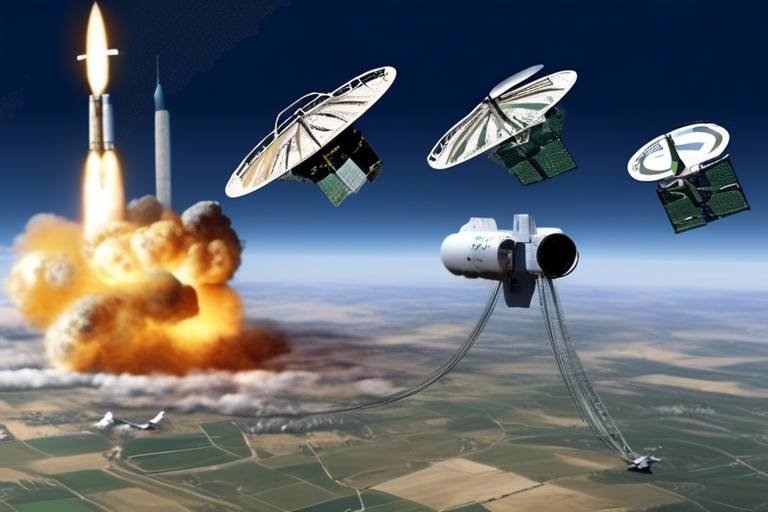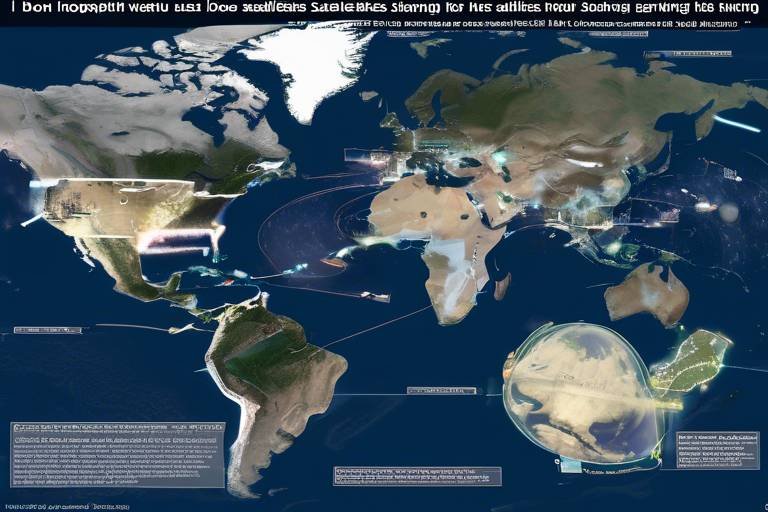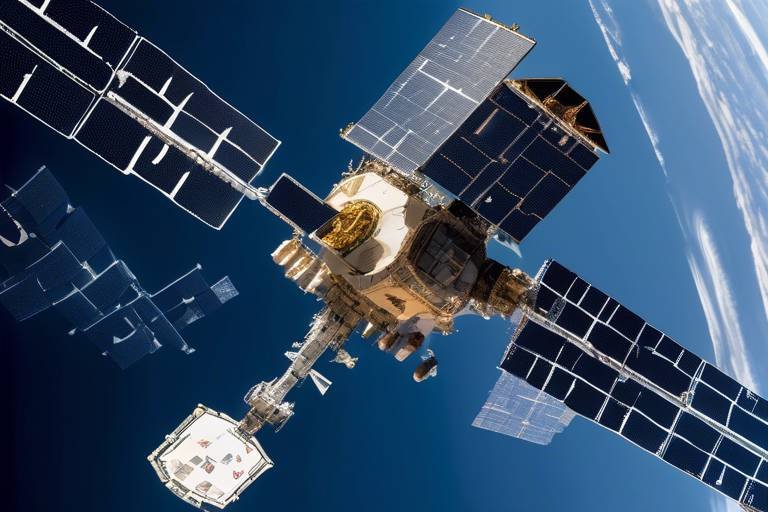How Satellites Enhance Air Defense Capabilities
In today's rapidly evolving security landscape, the role of satellites in air defense is nothing short of revolutionary. These high-tech marvels orbiting our planet are not just for navigation or weather forecasting; they are critical assets that bolster national security by providing unparalleled surveillance, communication, and threat detection capabilities. Imagine a vast eye in the sky that never blinks, constantly monitoring the airspace for potential dangers. This is the essence of how satellites enhance air defense systems, transforming the way we protect our skies and ensuring a proactive stance against aerial threats.
Satellites are the backbone of comprehensive surveillance capabilities in modern air defense systems. They enable real-time monitoring of airspace, identifying potential threats before they become imminent dangers. With advanced imaging technology, satellites can capture high-resolution images of vast areas, allowing air defense forces to maintain situational awareness. Think of it as having a bird's-eye view of everything happening in the sky, helping military analysts detect unusual patterns or movements that could signify an incoming threat.
Moreover, the integration of satellite data with ground-based radar systems enhances the overall effectiveness of surveillance. This synergy ensures that air defense units have access to the most accurate and timely information available, allowing for informed decision-making. In an age where seconds can mean the difference between safety and disaster, the ability to monitor airspace comprehensively is a game-changer.
Reliable communication is vital for effective air defense. In the heat of battle, when every second counts, the ability to communicate securely and instantaneously can mean the difference between thwarting an attack and facing dire consequences. Satellites facilitate this crucial communication between various defense units, ensuring coordinated responses to aerial threats.
Efficient data transmission from satellites allows for rapid processing of information. The technology behind this data handling is sophisticated, involving complex algorithms and secure channels that ensure information is transmitted quickly and accurately. Imagine a relay race where each runner must pass the baton flawlessly; this is akin to how data flows from satellites to ground units, ensuring that everyone is on the same page during critical operations.
Real-time intelligence sharing among military branches is crucial for effective response. Satellites enable seamless information flow, enhancing collaborative efforts in air defense strategies. When different branches of the military can share intelligence instantaneously, it creates a unified front against potential threats. This collaboration is akin to a well-rehearsed orchestra, where each musician plays their part in harmony to produce a powerful symphony of defense.
Advanced satellite communication systems ensure that air defense units remain connected during critical operations. These systems are designed to withstand various challenges, including electronic warfare attempts to disrupt communications. By utilizing multiple frequencies and robust encryption methods, satellite communication remains a reliable lifeline for air defense forces. In essence, these systems are the nervous system of military operations, transmitting vital information that keeps everything functioning smoothly.
The integration of satellite data with ground-based systems is essential for comprehensive air defense. By combining satellite imagery and data with local radar and defense systems, military forces can create a layered defense strategy that is both proactive and reactive. This synergy allows for a more robust response to aerial threats, as ground units can act on the information provided by satellites in real-time. It's like having a chessboard where every piece is aware of the others' movements, creating a cohesive strategy to counter any threats effectively.
Satellites significantly enhance the detection and tracking of aerial threats. With advanced sensors and tracking technologies, satellites can identify and monitor potential dangers in the airspace. This capability is crucial for national security, as it allows defense forces to anticipate and neutralize threats before they can cause harm.
Early warning systems powered by satellite technology provide crucial alerts about incoming threats. These systems function by continuously monitoring airspace and using sophisticated algorithms to analyze data for potential anomalies. When a threat is detected, alerts are sent out to relevant military units, enabling them to take immediate action. It's like having a smoke detector that not only alerts you to danger but also guides you on the best course of action to take.
Identifying and engaging targets is a critical aspect of air defense. Satellites assist in accurately identifying aerial threats and coordinating engagement efforts. By providing real-time data on the location, speed, and trajectory of potential threats, satellites enable air defense forces to make informed decisions on how to respond. This process is similar to a coach analyzing game footage to devise the best strategy for winning a match, ensuring that every move is calculated and effective.
- How do satellites improve air defense? Satellites enhance air defense by providing real-time surveillance, secure communication, and advanced threat detection capabilities.
- What technologies do satellites use for surveillance? Satellites utilize high-resolution imaging, radar systems, and advanced sensors to monitor airspace and detect potential threats.
- How do satellites facilitate communication between military units? Satellites enable secure and instantaneous communication, allowing various defense units to coordinate their responses effectively.
- What is the role of early warning systems? Early warning systems powered by satellites provide crucial alerts about incoming threats, allowing for proactive defense measures.
The Role of Satellites in Surveillance
In today's world, where threats can emerge from any corner of the globe, satellites have become the eyes in the sky, providing a level of surveillance that was once unimaginable. Imagine being able to monitor vast expanses of airspace in real-time, pinpointing potential dangers before they even become a concern. This is exactly what satellite technology offers to air defense forces. By leveraging advanced imaging and sensing technologies, satellites can capture high-resolution images and gather critical data on aerial activities, enhancing situational awareness and response capabilities.
One of the most significant advantages of satellite surveillance is its ability to operate 24/7, regardless of weather conditions. Unlike ground-based systems that may be hampered by fog, rain, or other environmental factors, satellites soar above the clouds, providing uninterrupted monitoring. They can detect everything from small drones to larger aircraft, ensuring that nothing goes unnoticed. This constant vigilance is crucial for national security, as it allows defense forces to stay one step ahead of potential threats.
Furthermore, the data collected by satellites is not just about spotting an object; it’s about understanding the context surrounding it. Advanced algorithms analyze movements and patterns, helping to differentiate between friendly and hostile activities. This capability is essential for effective air defense, as it allows military personnel to make informed decisions based on accurate intelligence. For instance, if a satellite detects an aircraft entering restricted airspace, it can immediately relay this information to ground control, enabling a swift response.
But how do satellites achieve this level of surveillance? The answer lies in a combination of technologies that work in harmony. Optical imaging satellites capture detailed images, while synthetic aperture radar (SAR) satellites can see through clouds and darkness. Additionally, signals intelligence (SIGINT) satellites intercept communications, providing insights into the intentions of aerial entities. Together, these systems create a comprehensive picture of airspace activity.
In summary, the role of satellites in surveillance is not just about watching over airspace; it’s about creating a robust defense network that enhances situational awareness and response capabilities. With the ability to monitor vast areas continuously, analyze data in real-time, and differentiate between various aerial activities, satellites are indispensable tools in modern air defense strategies.
Communication Enhancements through Satellites
When it comes to air defense, communication is the backbone that holds everything together. Imagine trying to navigate through a storm without a compass or map; that's what air defense units would face without reliable communication systems. Satellites have revolutionized the way defense forces communicate, providing a secure and instantaneous link between various units. This ensures that when a threat is detected, every team member is on the same page, ready to respond effectively.
One of the most significant advantages of satellite communication is its ability to transcend geographical barriers. Whether it's a fighter jet soaring high in the sky or a command center stationed miles away, satellites create a global network that enables seamless interaction. This means that even in the most remote locations, air defense units can maintain constant contact, sharing vital information that could mean the difference between thwarting an attack and facing dire consequences.
Moreover, the technology behind satellite communication systems has advanced tremendously. Modern satellites are equipped with sophisticated data encryption methods that ensure communications are kept secure from potential adversaries. This is crucial in military operations, where sensitive information must be protected at all costs. The ability to communicate securely allows air defense forces to discuss strategies and coordinate responses without the fear of interception.
Efficient data transmission is another key aspect of satellite communication. The technology that powers this capability involves a complex interplay of signal processing and data handling. When a satellite detects a potential aerial threat, it doesn't just send a simple alert; it transmits a wealth of information that includes the threat's location, speed, and trajectory. This data is processed in real-time, allowing military personnel to make informed decisions quickly. The speed at which this information is transmitted can be likened to a fast-paced relay race, where every second counts, and the baton—information—must be passed seamlessly to avoid losing the lead.
In the realm of air defense, real-time intelligence sharing is paramount. Satellites facilitate this by ensuring that information flows effortlessly between different military branches. For instance, if a radar station detects an unidentified object, that information can be transmitted to air defense units, ground forces, and even naval units almost instantaneously. This level of coordination enhances the overall response time and effectiveness of defense strategies. Think of it as a well-rehearsed orchestra, where each musician knows their part and plays in harmony to create a beautiful symphony of defense.
There are various satellite communication systems that play a role in enhancing air defense operations. These systems can be categorized based on their functionality and application. For instance, some systems are designed for voice communication, while others focus on data transmission or video conferencing. Each type serves a unique purpose, ensuring that all aspects of communication are covered. The integration of these systems allows for a comprehensive communication strategy that is robust and adaptable to any situation.
In conclusion, the enhancements in communication through satellites have transformed air defense capabilities. By providing secure, instantaneous, and efficient communication channels, satellites ensure that air defense units can coordinate their efforts effectively. As the threats in the airspace become more complex, the reliance on these advanced communication systems will only continue to grow, solidifying their role as a critical component of national security.
- How do satellites improve air defense communication?
Satellites provide secure and instantaneous communication links between various defense units, enabling coordinated responses to threats. - What types of information can satellites transmit?
Satellites can transmit a variety of data, including threat location, speed, trajectory, and even voice and video communications. - Why is real-time intelligence sharing important?
Real-time intelligence sharing allows for quicker decision-making and enhances the overall effectiveness of defense strategies. - Are satellite communications secure?
Yes, modern satellite communication systems employ advanced encryption methods to protect sensitive information from interception.
Data Transmission and Processing
In the realm of air defense, are the lifeblood that fuels decision-making and operational efficiency. Imagine a bustling city where every traffic light, pedestrian crossing, and emergency vehicle is interconnected, allowing for optimal flow and safety. Similarly, satellite systems play a pivotal role in ensuring that air defense units receive timely and accurate data from various sources. This data is not just numbers and codes; it represents real-time insights that can mean the difference between thwarting an aerial threat and facing an unexpected attack.
At the heart of this process lies sophisticated technology that enables satellites to transmit vast amounts of data back to ground stations. These systems utilize a variety of frequencies and protocols to ensure that information is sent securely and efficiently. The integration of advanced algorithms allows for the compression and prioritization of data, ensuring that the most critical information reaches decision-makers first. In essence, it’s like having a highly skilled team of chefs in a restaurant kitchen, where only the finest ingredients are selected for the signature dish, ensuring a perfect meal every time.
One of the most impressive aspects of satellite data transmission is its ability to operate in various environmental conditions. Whether it’s through stormy weather or the chaos of a battlefield, satellites are designed to maintain their communication links. This resilience is achieved through a combination of redundant systems and advanced signal processing techniques. For instance, if one communication channel faces interference, the system can seamlessly switch to an alternative channel without any loss of data. This capability is crucial for maintaining uninterrupted situational awareness.
Moreover, the data collected by satellites undergoes rapid processing at ground stations. This processing involves analyzing the incoming data streams to extract actionable intelligence. The use of artificial intelligence and machine learning algorithms has revolutionized this aspect, allowing for faster identification of patterns and anomalies that could indicate potential threats. It’s akin to having a skilled detective who can piece together clues from a crime scene in record time, leading to quicker resolutions.
In addition to real-time processing, the storage and archival of satellite data are also critical. Historical data can provide invaluable insights for future operations and strategies. For instance, analyzing past aerial threats can help defense forces predict and prepare for similar incidents. This long-term data analysis is like studying the weather patterns over years to forecast future storms accurately.
In summary, the seamless capabilities of satellite systems are essential for modern air defense. They provide the necessary infrastructure to support rapid decision-making and enhance situational awareness, ensuring that defense units are always a step ahead of potential threats. As technology continues to evolve, we can expect even greater advancements in how data is handled, making air defense systems more robust and effective than ever before.
- How do satellites improve air defense?
Satellites enhance air defense by providing real-time surveillance, secure communication, and advanced threat detection capabilities. - What role does data processing play in air defense?
Data processing allows for the rapid analysis of information collected from various sources, enabling timely decision-making during defense operations. - Are satellite communication systems reliable?
Yes, satellite communication systems are designed to be resilient, maintaining connections even in adverse conditions. - What technologies are used in satellite data transmission?
Advanced algorithms, frequency modulation, and signal processing techniques are employed to ensure efficient and secure data transmission.
Real-time Intelligence Sharing
In the fast-paced world of air defense, is not just a luxury; it’s a necessity. Imagine a scenario where a potential threat is detected but the information doesn’t reach the relevant defense units in time. The consequences could be catastrophic. This is where satellites come into play, acting as the backbone of communication and intelligence dissemination.
Satellites enable military branches to share critical information almost instantaneously, ensuring that every unit is on the same page. By utilizing advanced satellite communication systems, data regarding aerial threats can be relayed in real-time, allowing for quick decision-making and coordinated responses. This capability transforms how air defense forces operate, making them more agile and responsive to emerging threats.
For instance, when a satellite detects an unidentified aircraft entering a nation's airspace, the data is processed and shared with ground control and interceptor units within moments. This swift communication allows for a unified response, where all units can act in concert rather than in isolation. The effectiveness of this system can be illustrated in the following table:
| Time to Action | Unit Involved | Type of Threat | Response Action |
|---|---|---|---|
| Immediate | Ground Control | Unidentified Aircraft | Alert Interceptors |
| Within Minutes | Interceptor Units | Hostile Intent | Engage Target |
| Real-time | Command Center | Possible Threat | Assess and Direct |
Moreover, the integration of satellite data with ground systems enhances the situational awareness of all involved parties. This synergy means that every piece of intelligence is not only shared but also analyzed collectively, leading to more informed decisions. The beauty of this system lies in its ability to adapt and evolve; as new threats emerge, the intelligence-sharing framework can be updated in real-time, ensuring that air defense strategies remain effective.
In conclusion, the role of satellites in facilitating real-time intelligence sharing cannot be overstated. They create a network of information that is vital for the success of air defense operations. By ensuring that all military branches have access to the same data simultaneously, satellites help create a cohesive and effective defense strategy that ultimately enhances national security.
- How do satellites improve air defense? Satellites enhance air defense by providing real-time surveillance, facilitating secure communication, and enabling rapid threat detection.
- What is real-time intelligence sharing? It is the instantaneous exchange of critical information among military units to ensure coordinated responses to threats.
- Can satellites detect all aerial threats? While satellites significantly improve detection capabilities, they may not identify every threat due to limitations in technology and coverage.
Satellite Communication Systems
In the realm of air defense, play a pivotal role in ensuring that military units are connected and responsive during critical operations. Imagine a vast web of interconnected satellites orbiting the Earth, each one acting like a vigilant sentinel, ready to relay vital information to ground forces. These systems not only facilitate communication but also enhance operational efficiency, allowing air defense units to coordinate their actions seamlessly.
One of the most significant advantages of satellite communication systems is their ability to provide secure and instantaneous communication. This means that even in the midst of chaos, when traditional communication methods might fail, satellite systems ensure that commanders can issue orders and receive updates without delay. For example, during a simulated air attack, units can share real-time data regarding enemy movements and potential threats, ensuring a well-coordinated response.
Furthermore, these systems are equipped with advanced encryption technologies that protect sensitive information from interception. Imagine sending a message that not only reaches its destination but does so without the risk of being compromised. This level of security is crucial, especially when dealing with classified military operations.
Let's take a closer look at some of the key components of satellite communication systems:
| Component | Description |
|---|---|
| Transponders | Devices that receive signals from Earth and retransmit them back, enabling communication across vast distances. |
| Ground Stations | Facilities equipped with antennas and equipment to send and receive signals from satellites. |
| Satellite Networks | A constellation of satellites working together to provide comprehensive coverage and redundancy. |
Moreover, the integration of satellite communication systems with other technologies, such as data analytics and artificial intelligence, enhances their capabilities. This synergy allows for predictive analysis and quicker decision-making, which is essential in air defense scenarios. Picture a scenario where a satellite not only detects an aerial threat but also predicts its trajectory, allowing defense units to engage it effectively before it reaches its target.
In conclusion, satellite communication systems are the backbone of modern air defense strategies. They ensure that every unit is informed and ready to act, creating a cohesive defense network that can respond to threats swiftly and effectively. As technology continues to advance, we can expect these systems to evolve, further enhancing our national security and defense capabilities.
Integration with Ground Systems
In the realm of air defense, the integration of satellite data with ground-based systems is not just a luxury; it’s a necessity. Imagine trying to solve a puzzle without all the pieces—this is what air defense would look like without the synergy between satellites and ground systems. Satellites provide a bird’s-eye view of the battlefield, but it’s the ground systems that translate this aerial intelligence into actionable strategies. By combining these two domains, defense forces can achieve unparalleled situational awareness and operational efficiency.
One of the key advantages of this integration is the ability to enhance real-time decision-making. Ground systems equipped with satellite data can analyze incoming threats instantly, allowing military personnel to respond swiftly. For instance, if a satellite detects an unidentified aircraft entering restricted airspace, ground systems can quickly assess the situation and determine whether to scramble interceptors or engage in other defensive measures. This rapid response capability is crucial in scenarios where every second counts.
Furthermore, the integration facilitates the use of advanced technologies such as automated tracking systems and command and control centers. These systems rely heavily on satellite data to maintain an accurate picture of the airspace. For example, a command center can utilize satellite feeds to monitor multiple aerial targets simultaneously, providing operators with a comprehensive overview of potential threats. This not only improves the accuracy of threat assessments but also enhances coordination among various military branches.
To illustrate this point further, consider the following table that highlights the benefits of integrating satellite data with ground systems:
| Benefit | Description |
|---|---|
| Enhanced Situational Awareness | Ground systems receive real-time data from satellites, improving the understanding of the operational environment. |
| Rapid Response | Immediate access to satellite imagery allows for quick decision-making in response to threats. |
| Improved Coordination | Seamless data sharing between ground and aerial units enhances collaborative efforts in defense strategies. |
| Automated Tracking | Advanced systems can automatically track and identify multiple aerial targets using satellite data. |
In addition to these benefits, the integration also fosters a culture of collaboration. Military units can share information and resources more effectively, creating a unified front against potential threats. This collaborative approach is especially vital in joint operations, where multiple branches of the military must work together seamlessly. By leveraging satellite data, ground forces can communicate more effectively, ensuring that everyone is on the same page and ready to act.
Ultimately, the integration of satellite data with ground systems transforms air defense from a reactive posture to a proactive strategy. It empowers defense forces to anticipate threats before they materialize and respond with precision. As technology continues to evolve, the synergy between satellites and ground systems will only grow stronger, paving the way for more sophisticated and effective air defense capabilities.
- How do satellites improve air defense?
Satellites enhance air defense by providing real-time surveillance, facilitating communication, and aiding in threat detection. - What role do ground systems play in air defense?
Ground systems process satellite data to make informed decisions and coordinate responses to aerial threats. - Can satellite data be shared among different military branches?
Yes, satellite data can be shared seamlessly, improving collaboration and operational efficiency. - What technologies are used in the integration of satellites and ground systems?
Technologies include automated tracking systems, command and control centers, and advanced communication networks.
Threat Detection and Tracking
In today's world, where aerial threats can emerge from anywhere at any moment, the importance of cannot be overstated. Satellites play a pivotal role in this arena, transforming the way we perceive and respond to potential dangers in our airspace. By leveraging advanced technologies, satellites provide a comprehensive overview of aerial activities, enabling defense forces to remain vigilant and prepared.
One of the most significant advantages of satellite technology is its ability to monitor vast expanses of airspace in real-time. Imagine having a bird's-eye view of everything happening in the sky, from commercial flights to potential hostile aircraft. This capability not only enhances situational awareness but also enables air defense systems to identify and track threats before they become imminent dangers. With the ability to cover large areas and provide continuous surveillance, satellites are the backbone of modern air defense strategies.
Moreover, the integration of advanced sensors and imaging technologies into satellite systems allows for precise detection of various aerial objects. These sensors can differentiate between different types of aircraft, assess their speed and altitude, and even predict their flight paths. This information is crucial for military planners and decision-makers, as it allows them to evaluate the potential threat level and respond accordingly. The data collected by satellites is processed and analyzed using sophisticated algorithms, which further enhances the accuracy of threat identification.
To illustrate the impact of satellite technology on threat detection, consider the following table that outlines various systems and their capabilities:
| Satellite System | Capabilities | Key Features |
|---|---|---|
| Early Warning Satellites | Detect missile launches and aerial threats | Infrared sensors, real-time alerts |
| Reconnaissance Satellites | Gather intelligence on enemy movements | High-resolution imaging, multi-spectral analysis |
| Communication Satellites | Facilitate data sharing among defense units | Secure channels, low-latency transmission |
In addition to detection, tracking is another critical component of air defense. Once a potential threat has been identified, satellites provide continuous tracking capabilities, ensuring that defense forces can monitor its movements in real-time. This information is invaluable, especially when coordinating responses to aerial threats. For instance, if an unidentified aircraft approaches a sensitive area, the ability to track its trajectory allows military units to assess whether it poses a legitimate threat or if it is simply a civilian aircraft straying off course.
Furthermore, the synergy between satellite systems and ground-based radar technologies enhances overall tracking capabilities. Ground systems often rely on satellite data to fill in gaps in their coverage, ensuring that no potential threat goes undetected. This integration creates a robust defense network that can respond swiftly and effectively to any aerial intrusion.
In conclusion, the role of satellites in threat detection and tracking is indispensable in modern air defense. By providing real-time surveillance, accurate identification, and continuous tracking of aerial threats, satellites empower defense forces to act decisively and protect national security. As technology continues to evolve, we can expect even more sophisticated satellite systems to emerge, further enhancing our ability to detect and respond to aerial threats.
- What types of threats can satellites detect?
Satellites can detect various aerial threats, including missiles, aircraft, and drones, using advanced sensors and imaging technologies. - How do satellites improve communication in air defense?
Satellites facilitate secure and instantaneous communication between defense units, ensuring coordinated responses to aerial threats. - What is the role of early warning systems?
Early warning systems powered by satellites provide crucial alerts about incoming threats, allowing for proactive defense measures.
Early Warning Systems
In the realm of air defense, powered by satellite technology serve as the first line of defense against potential aerial threats. Imagine standing on a beach, watching for approaching storms; just as a vigilant observer can spot dark clouds from afar, these systems provide crucial alerts about incoming dangers. They utilize advanced sensors and tracking algorithms to monitor vast expanses of airspace, ensuring that military forces are always one step ahead of potential adversaries.
These systems function by continuously scanning the skies, analyzing data, and sending alerts to defense personnel. When a threat is detected, such as an incoming missile or hostile aircraft, the system instantly relays this information to command centers, allowing for rapid decision-making and response. This capability is vital in today’s fast-paced military environment, where every second counts. The integration of satellite technology with ground-based radar systems enhances the effectiveness of early warning systems, creating a comprehensive defense network that can react swiftly to evolving threats.
To illustrate the efficiency of early warning systems, consider the following key components:
| Component | Description |
|---|---|
| Satellite Sensors | These collect data on aerial movements and environmental conditions, providing real-time surveillance. |
| Data Processing Units | Advanced algorithms analyze incoming data to identify potential threats quickly. |
| Communication Links | Secure channels ensure that alerts and data are transmitted without delay to ground forces. |
| Command Centers | Central hubs where information is collated and decisions are made regarding responses to threats. |
Moreover, early warning systems are not just about detection; they play a crucial role in strategic planning and operational readiness. By providing detailed intelligence on potential threats, these systems enable military leaders to devise effective countermeasures and allocate resources where they are most needed. In essence, they transform raw data into actionable insights, enhancing the overall effectiveness of air defense strategies.
In conclusion, the integration of satellite technology into early warning systems represents a significant advancement in air defense capabilities. As threats become more sophisticated, the ability to detect and respond promptly is paramount. This technology not only protects national airspace but also fosters a sense of security for citizens, ensuring that military forces are always prepared for any eventuality.
- What are early warning systems?
Early warning systems are technological frameworks designed to detect potential threats in airspace, providing timely alerts to military forces. - How do satellites enhance early warning systems?
Satellites improve early warning systems by providing real-time data and surveillance capabilities, allowing for rapid detection and response to aerial threats. - What role do communication links play in these systems?
Communication links are essential for transmitting alerts and data securely and efficiently between satellites and ground-based command centers. - Can early warning systems prevent attacks?
While they cannot prevent attacks, early warning systems significantly enhance the ability to respond to threats before they escalate.
Target Identification and Engagement
In the realm of air defense, is not just a tactical necessity; it's a matter of national security. Imagine a chess game where each piece represents an aerial threat, and your ability to identify and engage those pieces effectively determines the outcome. Satellites play a pivotal role in this high-stakes game by providing the necessary intelligence to distinguish between friend and foe in real-time.
Utilizing advanced imaging technologies, satellites can capture detailed images of objects in the airspace. These images are processed using sophisticated algorithms to analyze their size, shape, and movement patterns. This process is akin to putting together a puzzle; each piece of data helps create a clearer picture of what’s happening in the skies above. For instance, distinguishing between a commercial airliner and a military aircraft is crucial, as misidentification could lead to catastrophic consequences.
Moreover, satellites are equipped with synthetic aperture radar (SAR) and other sensing technologies that enhance their ability to detect and track moving targets. This capability allows defense forces to monitor multiple aerial threats simultaneously, ensuring that no potential danger goes unnoticed. The data collected is then transmitted to ground control stations, where defense personnel can make informed decisions about engagement strategies.
Once a target is identified, the next phase involves engagement, which requires rapid coordination among various defense units. Here, the satellite's role shifts from data gathering to facilitating communication. A well-coordinated response can mean the difference between neutralizing a threat and facing a potential disaster. For example, if a hostile aircraft is detected, satellite systems can relay information to interceptor jets, ground-based missile systems, and command centers almost instantaneously. This seamless integration of data and communication ensures that all units are on the same page, ready to act swiftly.
To illustrate the importance of this process, consider the following table that outlines the key components involved in target identification and engagement:
| Component | Description | Importance |
|---|---|---|
| Imaging Technology | Captures detailed aerial images for analysis. | Essential for distinguishing between various types of aircraft. |
| Synthetic Aperture Radar (SAR) | Provides high-resolution images regardless of weather conditions. | Crucial for tracking moving targets in real-time. |
| Data Transmission | Facilitates the rapid sharing of intelligence across units. | Ensures timely decision-making and coordinated responses. |
| Engagement Coordination | Involves multiple defense units responding to a threat. | Critical for effective neutralization of aerial threats. |
In conclusion, the synergy between satellites and ground-based systems is indispensable for modern air defense. The ability to identify and engage targets efficiently not only enhances operational readiness but also fortifies national security. As technology continues to evolve, the integration of satellite capabilities into air defense strategies will undoubtedly become even more sophisticated, ensuring that nations remain vigilant and prepared against aerial threats.
- How do satellites improve air defense?
Satellites enhance air defense by providing real-time surveillance, facilitating secure communication, and enabling precise target identification and engagement. - What technologies do satellites use for target identification?
Satellites utilize advanced imaging technologies, synthetic aperture radar (SAR), and data processing algorithms to identify aerial threats accurately. - Why is communication important in air defense?
Reliable communication ensures that all defense units can coordinate their responses to threats effectively, minimizing the risk of miscommunication during critical operations. - Can satellites operate in adverse weather conditions?
Yes, technologies like synthetic aperture radar (SAR) allow satellites to capture images and track targets regardless of weather conditions.
Frequently Asked Questions
-
How do satellites improve air defense surveillance?
Satellites enhance air defense surveillance by providing real-time monitoring of airspace. They utilize advanced imaging technology to detect and track aerial movements, allowing air defense forces to maintain situational awareness and respond swiftly to potential threats.
-
What role do satellites play in communication for air defense?
Satellites are crucial for secure and instantaneous communication between various defense units. They ensure that all branches of the military can coordinate effectively and share vital information during critical operations, ultimately leading to a more unified response to aerial threats.
-
How does data transmission from satellites affect decision-making?
Efficient data transmission from satellites allows for rapid processing of information. This capability is essential for making informed decisions during air defense operations, as it provides commanders with the timely intelligence needed to assess threats and deploy resources effectively.
-
What is the significance of real-time intelligence sharing?
Real-time intelligence sharing is vital for effective air defense strategies. Satellites facilitate seamless communication between military branches, ensuring that all units have access to the same information, which enhances collaboration and improves overall operational efficiency.
-
How do satellites contribute to early warning systems?
Satellites power early warning systems by providing crucial alerts about incoming threats. These systems monitor airspace continuously and utilize satellite data to detect potential dangers, allowing defense forces to take proactive measures before threats materialize.
-
What technologies are used in satellites for threat detection?
Satellites use a combination of radar, infrared, and advanced imaging technologies for threat detection. These tools enable them to identify and track aerial threats accurately, ensuring that air defense forces can engage targets effectively.
-
How do satellites assist in target identification and engagement?
Satellites play a crucial role in accurately identifying aerial threats and coordinating engagement efforts. By providing detailed information about the location and movement of potential targets, they help air defense units make informed decisions about how to respond.

